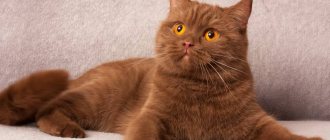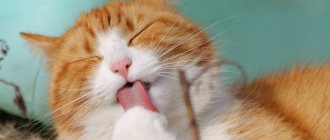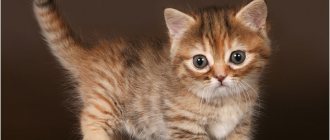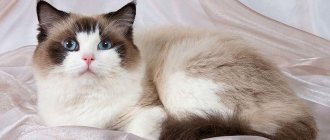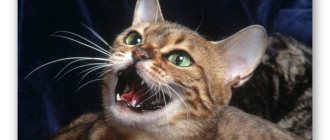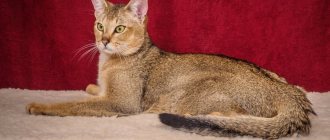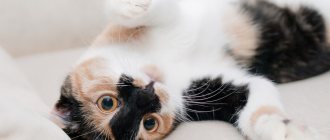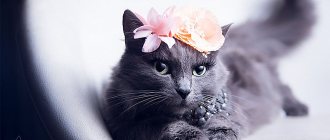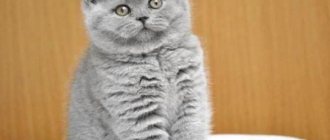International felinological organizations have registered about three hundred cat breeds to date. Some of them arose from ancient natural species, others are the result of mutation and selection work.
Each type of cat requires specific care and conditions. Therefore, they approach the choice of a pet responsibly. There are rare breeds of cats that stand out not only for their beauty, but also for their cost.
Rex
The main distinguishing feature of Rex cats is their wavy fur. This feature appeared due to natural genetic mutations and was fixed through selection.
Varieties and appearance
There are three main types of rex.
Cornish Rex
Originally from England, Cornwall. The head is small, with pronounced cheekbones. The body is graceful, flexible, the limbs are long and slender. The guard hairs are very thin, the same length as the undercoat. Both types of fur curl in one direction, towards the skin.
Cornish Rex cats are particularly flexible and elegant.
Devon rex
The first individuals also appeared in England, in the county of Devonshire. The head is short and wide, with a strong chin. The body is muscular, with a broad chest. There is no outer coat, the guard hairs are longer and thicker than the undercoat. The waves of these types of wool are directed in different directions.
Cornish and Devonian are recognized by all major felinological organizations.
The Devon Rex's fur and undercoat are curled in different directions.
German rexes
The first animals were discovered in eastern Prussia. The head is rounded, with a pronounced chin and cheeks. The body is strong and strong, but not massive. Legs are thin, of medium length. The structure of the coat corresponds to the type of Cornish Rex.
German Rexes are recognized by FIFe, WCF and SCFF. The CFA is currently refusing to register them due to their being too similar to English types.
German rexes are strong and robust animals.
In addition to the main branches, there are two more young but promising rex breeds.
Selkirk Rex
A breed of American selection. The head is round and wide, with pronounced cheeks. Persian cats were used in breeding work, so the muzzle is slightly shortened. The body is rectangular, muscular, with strong bones.
The coat is thick, without topcoat, with large waves. Can be short or long. As a rule, kittens are born very curly. At about 2 months, the coat straightens, and starting from 8–10 months, it curls again.
The breed is recognized by ACF, WCF, CFA, TICA, ACFA.
The American variety of Rex quickly gained popularity
Ural rex
The first mentions of this aboriginal breed date back to the 40s. last century, but thorough breeding work began only in 1992.
The head is shaped like a short, wide wedge with pronounced cheekbones. The body is muscular, yet slender. The coat is of medium length, with very little outer hair. The curls are clear, without a specific direction.
Among the international organizations, the breed was recognized by the WCF.
The Ural Rex is an indigenous breed that has only recently attracted the attention of breeders
In addition, there are other, less common breeds of cats with wavy hair: Oregon, Tennessee, Missouri Rex, etc. Some of them are now in their infancy, others, having existed for some time, “dissolved” in the main branches or disappeared after cessation of breeding work.
Character
All rexes are famous for their friendliness and affection. These are pronounced companions who strive for human society and have a hard time enduring loneliness. Quite patient with children.
They strive for physical contact, and Cornish and Devonians prefer to sit not on a person’s lap, but on a person’s shoulders.
In childhood they are very active. With age, activity becomes more moderate, but rarely turns into laziness. They love heights and often climb to the highest points in the house.
Before purchasing such an animal, you need to take into account that many rexes are very “talkative” and often meow.
They are inquisitive, intelligent and can learn a number of commands and tricks. Some wear aport on their own initiative. Most quickly learn the rules of behavior in the house, although some can be headstrong.
German rexes especially quickly get used to the daily routine and often begin to wait for their owner at the door in advance. They are characterized by special neatness: according to reviews, many of them treat their toys very carefully and, after frolicking, independently take them to a secluded place.
Many rexes are sensitive to the mood of their owner and even try to console him if he is upset.
On the plus side, Devons are very affectionate and follow a person with their tail. And they are also very talkative, and not just Meow, but also MEAYAYA, Myak (short) or MEYak, my favorite sound is Ek (surprisingly short). You come home tired from work and Niba - say Ek! ...Eck! And it feels so good right away. When you eat, he unceremoniously climbs into your arms, and when you are just sitting somewhere, he will sit opposite you and Meow until you pat your knees and say “Niba, come here,” he runs, jumps up and sleeps. She can accompany the whole evening with her voice. I was cooking recently, and she was sitting opposite me - she opened her mouth and so on with an aspirated “K”. While I was cutting the salad, I started counting these “K”s 37 times without a break)
zvezdafur
https://irecommend.ru/content/devon-dobav-bezumiya-v-svoyu-zhizn
Features of care
The soft coat of the main rex groups does not require complex care. It is combed with a natural brush once every two weeks. Shedding occurs almost unnoticed, but at this time the frequency of brushing increases to once a week.
Some breeders recommend wiping animals with chamois every day: this helps maintain the shine of the coat and “keep the curl.”
Rexes are bathed approximately once every two months using mild shampoos for short-haired breeds. You cannot use a hairdryer for drying - due to hot air, the wool becomes brittle and loses its shine.
It is important not to overfeed the animal - due to their accelerated metabolism, rexes love to eat and often beg for more. There should be no poisonous plants in the house so that the pet does not get poisoned by tasting them.
Nails are trimmed about twice a month.
Photo gallery: rex
Rexes get bored alone, so you can get a companion for your pet
Baby rexes are very active
Rexes love to watch their owners and try to take part in all their affairs.
Rexes come in many colors
Female rexes are caring mothers
Bambino
The Bambino cat is much more agile than it seems
Another hero of the list is the bambino. A hairless breed of cat with short legs. As you might guess, she appeared as a result of crossing a munchkin and a sphinx.
The history of the bambino began in 2000, when a short little munchkin was brought to the Sphynx nursery of the Osborne couple from Arkansas. Breeders immediately became interested in what would happen if two unusual breeds were crossed. The result can be seen in the photo: a small naked miracle with a large head on short legs. Bambino is translated from Spanish as “child”.
It is interesting that, in parallel with American breeders, a similar breed was bred in Russia, in the nursery of the Chernov sisters, Baby Moon Cattery. In 2005, when their cats were officially registered, there were already 4 generations.
Bambinos are not known for their grace and sophistication, but they are funny and funny. Surprisingly agile and jumping. Absolutely devoid of aggression and hunting instincts. The average price of a bambino in nurseries is $800.
Laperm
The LaPerm is another breed with a wavy coat. Some classify it as a member of the rex group, others believe that there are important differences that allow it to be placed apart.
First of all, this is a dominant gene for curly hair - in the three main groups of rexes it is recessive. In this respect, Laperms are similar to the Selkirk Rex.
Laprems differ from Selkirks by having a longer snout.
The first kitten, which became the founder of the breed, was born in Dallas. Interestingly, the animal was initially bald, like a sphinx, but by two months it began to be covered with curly hair.
The name of the breed comes from the word “perm” - permanent wave.
At the moment, the breed is recognized by all major felinological organizations.
There is a dwarf variety of laperm - skukum.
Appearance
According to CFA standards, the head is shaped like a modified wedge, with full whisker pads. The ears are cupped, tassels are allowed. The eyes are almond-shaped.
Body of medium size, proportional. The average weight of females is 2-4 kg, males - 4-6 kg. The croup is slightly higher than the shoulders.
Any color is allowed. The coat can be semi-long or short.
The half-long one should be airy and loose, easily moving apart with breathing. Outwardly, she usually looks shaggy. Length and density may vary depending on the season.
The short coat is springy and soft, but slightly harsher than the half-long coat.
Laperms always look a little shaggy
Character
Laperm is a gentle and sociable animal. These cats often purr in the presence of their owners, even if they are not petted. Loneliness is extremely painful to bear.
They love to sit on hands, often reach out to a human face, and, if possible, try to touch it with their paws, lick it and “kiss” it.
Many representatives of this breed love to watch TV with their owner, and often do this with amusing emotionality.
They are quite active and need outdoor games. Travel easily.
Care
Brush the animal about once a week. It is important to carry out regular flea treatment - they often infect this particular breed.
Like rexes, laperms should not be dried with a hairdryer - it can straighten the fur. On the contrary, after drying, you can spray it with a little water so that the curls are better expressed.
Photo gallery: Laperm cats
Semi-longhaired Laperms have a pronounced collar
Laperms prefer to spend maximum time with their owners
Any color is allowed for laperms
Sphinxes
Hairless cats appeared relatively recently, but managed to gain enormous popularity.
Main breeds
There are several breeds of Sphynx.
Canadian
The oldest variety. The first representative was the kitten Prune, born in Toronto. Subsequently, most of the breeding work took place in the USA and Holland. The breed is recognized by all major felinological organizations.
The head is slightly longer than wide. The ears are large, the muzzle has pronounced cheekbones and a strong chin.
The body is muscular, heavy, with a convex belly. Legs are strong. Short hair is allowed on the paws, tail, ears, and scrotum. The rest of the body may be completely bald or covered with down of no more than 2 mm.
Canadian Sphynxes appeared as a result of a random mutation
Based on this breed, a number of hybrids have been bred, for example, elves - hairless cats with curled ears.
Don
The breed comes from Rostov-on-Don. Its ancestor was the cat Varvara, who was picked up on the street.
The breed is recognized by the WCF.
The head is wedge-shaped, the cheekbones and eyebrows are sharply defined. The ears are large. The body is strong, with a deep groin line.
Donchak dogs can be completely hairless or with coat types such as:
- flock - hairs are almost invisible in appearance;
- velor - hairs 2–3 mm;
- brush - relatively long and stiff wool.
The latter type is used for breeding and participates in exhibitions, but without the right to receive titles.
Completely hairless Don Chaks are considered the most striking and valuable representatives of the breed.
Peterbalds
Breeders purposefully created this breed by crossing the Don Sphynx and an Oriental cat. In further work, animals of the Siamese-Oriental group were also used.
The breed is recognized by CFF, TICA and WCF.
The head is wedge-shaped, narrow. The ears are large, the tips are spread apart. The eyes are almond-shaped. The physique is oriental: the body is elongated, flexible and thin, the limbs are long and slender. The coat types are the same as those of the Don Sphynski.
Peterbalds adopted the leanness and grace from their oriental ancestors
Character
Sphynxes are good-natured and affectionate pets that are extremely in need of human society. They prefer to spend as much time as possible with the owner, while actively trying to participate in his affairs, which is why they can be intrusive. Loneliness is very difficult to tolerate.
At the same time, they never curry favor with people, preferring equality. They are inquisitive and smart, capable of funny tricks and pranks. They are trained to walk on a leash. They are very active in childhood. They are not vindictive and patient with children. They get along peacefully with other non-aggressive animals. They can be quite talkative. This is especially often said about Peterbalds, who inherited this trait from their “eastern” ancestors. May be unclean when going to the toilet.
Of all the Sphynx breeds, I liked the Canadian Sphynx the most in appearance and character. […] After only half an hour of being in our family, the little mischief immediately made it clear that not a single thing in the house could be done without her: bills, drawers, cabinets, bags, a manicure lamp, tools - all new items that happen to be nearby are a must must go through strict control of Blueberries! She is very curious.
timofeeva_natalia
https://irecommend.ru/content/pro-nashego-druga-i-chlena-semi-kanadtsa-cherniku-mnogo-teksta-pro-zavodchikov-povedenie-kha
Care
The skin of Sphynx cats produces a specific brown “sweat”, so they need to be bathed about twice a month. In addition, the animal is regularly wiped with veterinary wipes.
It is important that the house is warm. Sphynxes love to bask in the sun, and in the heat they can get sunburned or get heatstroke. Dry air, feeding errors and a number of other factors lead to flaking of the skin. In this case, the pet can be lubricated with baby oil. You cannot indulge the immoderate appetite of these animals.
Video: features of caring for sphinxes
Rare long-haired breeds
Long-haired cats require special care and cost a lot of money (for example, the price of a purebred American Bobtail varies from two to three thousand dollars). TOP rare breeds with long hair:
| Name | Peculiarities |
| Laperm | Appeared in the USA in the 80s. The color is smoky, black, white. Eyes of a heavenly tone. A distinctive feature is the curly coat. |
| American Bobtail | Descendants of the North American cat. Brought out in the sixties. Large dimensions. The ears are pointed and stick up. The color is often tortoiseshell. |
| American Curl | In demand in the USA, rarely found outside the country. Cats' ears are turned in the opposite direction. There are also short-haired individuals. |
| Ragamuffin | The ancestors are street cats. Most nurseries of these animals of various colors and fluffy fur are located in America. |
| Napoleon | They appeared at the beginning of the second millennium when mating a Persian cat with a Munchkin. They are distinguished by shortened limbs, long hair, and a slightly flattened muzzle. Good-natured and obedient. |
| Turkish Van | The oldest and largest breed. The weight of the male reaches 7 kg. Length - 1.2 meters. The coloring is varied. |
Munchkin
The main feature of these cats is their short legs. The first representative of the breed was the Blackberry stray cat, which was found in 1983 in the USA.
The breed is recognized by TICA and WCF.
CFA and GCCF refuse registration because they consider short legs to be a defect that reduces the quality of life of the animal.
Appearance
The head is shaped like a modified wedge, slightly rounded. The cheekbones are high and may be more noticeable in males. The ears are wide at the base, set high and wide. The eyes are almond-shaped.
The body is long, with a rounded chest and firm hips. The tail is equal to the length of the body and should be raised up when moving. The weight of an adult animal is 2–4.5 kg. The legs are short, about 13 cm.
The coat is allowed to be short or semi-long. In the second case, the animal may have tufts on its ears.
Short legs give munchkins a weasel-like appearance.
Character
Munchkins are cheerful, active and friendly pets. They love human society, but do not depend on it and tolerate loneliness well.
As a rule, they treat children and strangers peacefully.
They are very curious, love to explore unfamiliar places and new objects. They tolerate walking on a leash and long trips with their owners well.
One of the most curious features of the breed is that when a munchkin is surprised or interested in something, it stands on its hind legs, pressing its front legs to its chest and leaning on its tail. A cat can stand like this for a relatively long time.
For many owners, the munchkins' way of standing on their hind legs seems no less exotic than their short limbs.
Despite their short legs, munchkins move quickly, confidently and gracefully, and stomp quite loudly. The manner of movement is somewhat similar to that of ferrets or mongooses. They love active games, although they do not jump as high as other cats.
According to a number of reviews, munchkins tend to “borrow” and hide things they like in secluded places.
If a munchkin doesn’t have a cat’s house or is not happy with it in some way, the animal will try to build a home from “survival materials.”
Very intelligent cats, they know how to think, analyze, draw conclusions, they learn everything so quickly, even what they shouldn’t (for example, how to open drawers and doors). For comparison: I also have a noble cat, their thinking is quite different. If I throw a toy and it flies behind the sofa, the cat will jump on the back of the sofa and look where it fell. The cat will not climb onto the sofa, he will assess the situation and immediately crawl under the sofa, guessing that the toy is already there. If I point my finger in the corner and say that the toy is there, the cat will come up to me and look at the finger, the cat will go where I point.
Ainnka
https://irecommend.ru/content/manchkiny-lyubov-odnazhdy-lyubov-navsegda
Care
Short-haired individuals are combed once a week, semi-long-haired individuals - 2-3 times. The animal is bathed approximately once every 3 months.
Munchkins are prone to tartar formation, so they need to brush their teeth at least once a week.
Video: Munchkin - all about the breed
American Curl
The American Curl's ears can be curled back to varying degrees, the more, the more valuable he is.
A breed of semi-longhaired cats with unique curled back ears. The first American Curls appeared in 1981 from an ordinary black cat named Shulamith, living in California.
Kittens are born with straight ears, which begin to curl within 48 hours and take up to 3-4 months to develop. In adult cats, they should be firm and stiff to the touch at the base, but with flexible tips.
The American Curl gave rise to several new breeds. The average cost in nurseries is $750.
Manx
The main feature of these cats is the absence of a tail.
The breed was formed mainly in the wild, on the Isles of Man (Great Britain). According to legend, the ancestors of Manx cats were former sailor cats who survived shipwrecks. The tailless gene, which appeared due to a random mutation, soon became dominant in this peculiar community, and gradually the trait began to be passed on to all kittens.
After some time, animals began to be imported to Europe. The first breed standard was published already in 1903. Now Manxes are recognized by all major felinological organizations.
Manx cat formed in the wild
Appearance
The head is round, wide, with prominent cheekbones. The eyes are large and slanted. The ears are large, with rounded tips. The neck is strong and short.
The body is square, the croup is round. The hind limbs are longer. Paws are rounded. Weight ranges from 3.5 to 5.5 kg.
Tail Types:
- Dimple rumpy or rumpy - the caudal vertebrae are missing, in their place you can feel a fossa;
- Riser or rumpy riser - vertebrae hidden under fur;
- Stumpy - 1–3 visible vertebrae;
- Tailed or longy is a regular tail.
The wool is plush to the touch.
One of the characteristic features of this breed is the roundness of all shapes.
Character
Manxes are cats of one owner, and they choose him at their own discretion. The attitude towards the rest of the household is friendly, but rather restrained.
According to reviews, many Manx cats define their “rank” in the family as second after the main owner.
They are active and playful and jump very high. They often bring abandoned toys on their own initiative. They love to look at the water and play with the streams from the tap, but not to swim.
They get along well with dogs and other cats, but if necessary they can defend their interests quite harshly.
You should not allow access to small animals - Manx are excellent hunters.
My relatives got Manx. They first became acquainted with his agility when the kitten jumped without a run onto the lid of a rather high-standing aquarium. The glass underneath him slid sideways, and he himself ended up in the water, so there was quite a commotion. Since then, the aquarium has been covered with a special plastic lid, and all fragile items have been removed from the shelves. Not in vain - with age, this cat learned to take a height almost as tall as a man.
Care
Manx cats are brushed once a week, and during the molting period - every 1-2 days.
The breed is susceptible to tartar formation, so teeth should be brushed at least once a week, if possible more often.
Photo gallery: Menk cats
Animals with a complete absence of tails are rated highest at shows.
Manx cats benefit from walks in the fresh air.
Manx cats have a well-developed hunting instinct.
Manx are strong and resilient animals.
Although the average weight of Manx is relatively small, they look very massive
Foldex
Foldex resembles a round furball with expressive eyes
Foldex managed to divide the world of felinologists into two camps: in one there were fans of the cute creature, and in the other there were skeptics who claim that the source material will not produce a healthy breed.
The breed was developed in the early 90s by Canadian felinologist Betty-Ann Yaxley. The breeding program included British cats, Scottish Folds, Persians and exotics. Foldexy resembles a round ball of wool with expressive eyes. The wool is plush, very soft and thick. Colors can be varied.
The owners say that Foldex cats are good-natured and sweet, they love their owner very much and get along well with other pets. They are not aggressive and do not know how to fight. Flexible and smart. The price is proportional to the quality. On average, a kitten in a nursery costs $1,000.
Bobtails
Also a short-tailed group of cats. As a rule, bobtails are distinguished by their large size and dense, wet-resistant coat.
Tails can be of the following forms:
- Stump. From 2 to 5 cm. There are breaks at an obtuse angle.
- Spiral. The apparent length is 5–10 cm. There are numerous fractures, often at sharp angles.
- Retracted bobtail. Near the base the tail is normal, after 5–7 vertebrae kinks begin.
- Panicle. Length from 5 to 15 cm, breaks at right angles.
Bobtail breeds
There are several breeds of bobtails.
American
The head is wedge-shaped. The body is moderately long, the back is straight. Weight 3–8 kg. The coat can be short or semi-long.
Yankeebobs with semi-long hair should have a collar
Japanese
The head is triangular. Individuals with eyes of different colors are often found. The body is oblong, muscular, but not massive. Weight 3.5–5 kg. The coat is short.
In Japan, this cat symbolizes friendship, in Korea and China - well-being.
Kuril
The head is in the shape of an equilateral triangle. The body is strong and muscular. Weight 3–7 kg. The coat is semi-long and thick. There may be tufts on the ears, making the animal look very much like a lynx.
Thick, warm fur helped Kurilian Bobtails survive in the wild
Mekong
The head is rounded. The body is rectangular in shape, but quite slender. The only colors allowed are Siamese. Weight 2.5–5 kg.
According to legend, these animals accompanied the princesses, and while they were bathing, they strung jewelry onto the cats' broken tails.
Karelian
The head is triangular, the muzzle is narrow. The body is strong, the hind legs are noticeably longer. The coat can be short or semi-long.
Karelian Bobtail is the rarest variety
Character
Bobtails are conspicuous companions. They love to spend time in human society and are painfully sensitive to loneliness.
The most independent bobtails are the Mekong.
Most of these animals are very active and love outdoor games. They are smart and often have developed logical thinking. Most often they respond well to training. Usually travel easily.
As a rule, they get along peacefully with cats and dogs. Most of all, the “Japanese” love the company of other animals, and they prefer to be friends with representatives of their own breed.
The hunting instinct is pronounced. Many bobtails are excellent rat catchers, and some - for example, Kuril and Japanese - can fish.
Most are quite sociable, often making rich intonation sounds similar to chirping or abrupt yelps, but not to a regular meow.
The quietest and calmest of bobtails are Karelian. If such a cat needs something from its owner, he would rather touch it with his paw than meow.
Moti's character is simply unique. It’s not for nothing that kurbob is called cotops. He chose me as his owner, and it's obvious. He only sits in my arms and follows me around the house. My husband says that he even feels when I should come - he runs to the door. And when I’m not home for a couple of days, the cat... howls. Drawingly, long, like a dog. Despite the fact that both his husband and mother feed him, he keeps them at a distance. Bored, my red “Hachiko” curls up on some of my clothes. I even specially leave him some old things if I’m away for a long time, as an “anti-stress.”
Martovskaya
https://irecommend.ru/content/ne-pakhnet-i-ne-metit-ili-antikvar-v-koshachei-shkure-zabavnye-foto
Care
Short-haired bobtails are usually brushed once a week, while semi-long-haired ones are brushed once every 2-3 days. During the molting period, this is done daily. If necessary, you can bathe the animal approximately once every 2 months.
Video: Kurilian Bobtail - all the details about the breed
Savannah
This young breed is the result of crossing wild servals and domestic cats. The first viable kitten was born in 1986.
At the moment, savanna is only recognized by TICA. Other organizations refuse registration due to the lack of stable characteristics in the breed.
Appearance
These are large animals, with a body and tail up to 135 cm in length. Weight from 7 to 15 kg.
The head is wedge-shaped, relatively small. The whisker pads are weakly expressed. The nose is wide. The ears are large, very wide at the base.
The body is elongated, with a strong chest, strong shoulders and hips. The limbs are long, the groin line is lean.
The coat is short and thick, with leopard spots.
The F1 generation, that is, obtained directly from the mating of a wild and domestic animal, has the most striking characteristics of the breed. Males from these matings are sterile until the 4th–5th generation, so females are mated with domestic cats, and the signs of wild blood gradually fade.
F1 generation cats are most similar to wild animals
Character
With proper upbringing, it is an intelligent and obedient pet. He gets attached to people, loves to spend time with them and may even wait near the door when he gets home from work. At the same time, he calmly endures loneliness.
Representatives of the breed are distinguished by curiosity, courage and mobility. They need plenty of space to play, otherwise the behavior can become destructive.
Savannah needs room to play
Savannah usually gets along well with other cats and dogs, and prefers to be friends with the latter if they recognize her as their “leader”.
These cats love water and, if possible, willingly swim in pools and ponds. They love to throw toys into a full bath and then catch them with their paws.
They jump up to 2.5–3 m in height, so it is not advisable to keep fragile things on the top shelves.
In an animal of the F1 generation, after the age of three, wild character traits may intensify. It is strictly not recommended for families with children to have such a cat.
Care
The animal should have enough space to burn off its energy, ideally an enclosure with a mini-pool attached to the house. In addition, it is advisable to walk, like for a dog, for 1–2 hours.
The coat is combed once a week.
Savannah does not tolerate cold well, so in winter you need to take care of insulating your house.
Video: origin and description of the Savannah cat breed
Rare and expensive
List of the most expensive (cost in dollars):
- Laperm - three hundred to two thousand;
- Serengeti - six hundred to two thousand;
- Elf - six hundred to two thousand;
- Kao-Mani - seven to ten thousand;
- Savannah - from twenty-two to one hundred thousand.
Also read the article about the most expensive cat breeds.
The cost of a rare pet depends on its class, gender, and nursery. A PET-class kitten (without documents) will cost several times less than an individual from titled parents. The cost of females is usually higher than that of males. In foreign nurseries, animals are more expensive.
Read the article about the most beautiful cat breeds.
Persian teacup cat
This is a miniature variety of the common Persian cat. Selection work began in 1995 and at the moment the breed is experimental. There are nurseries in the USA, Canada and the UK. No organization has yet recognized the tea Persians.
In English the breed is called "Teacup", that is, teacup
Mini Persians have completely inherited the proportions of the original breed. They have a squat body with a relatively broad chest, a round head and a flattened muzzle. The wool is long. As a rule, the weight of an adult animal does not exceed 2–3 kg.
Since there is no single standard yet, weights and sizes may vary depending on the nursery.
A number of breeders warn that the breed is even sicker than regular Persians and has a shorter life expectancy. Others deny this, assuring that all examinations show excellent health. At the moment, it is difficult to say whether this is explained by the honesty or dishonesty of the sellers, or by different successes in breeding work.
The popularity of mini characters is growing rapidly
leopard cat
Bright spotted color is a distinctive feature of Bengal cats. They have short golden fur, which gives them a resemblance to their wild relatives.
The first representative appeared in the mid-20th century, when a wild Bengal cat, bought on the black market, gave birth to offspring from a domestic cat. This is how the animal turned out with a gentle disposition and a predatory coloration. This is a happy occasion, because such crossing almost never ends in success.
Unusual wild cats
There are several unusual and little-known species of wild cats.
Viverrid fishing cat
This animal lives in southeast Asia. Males weigh 11–15 kg, females 6–7 kg. Body length with tail - 96–120 cm.
The basis of this cat's diet is fish. During the hunt, the animal enters the water and freezes, waiting until the prey loses its vigilance and swims closer. Sometimes fishermen resort to a trick: they lightly move their paw through the water, imitating the movement of a fallen insect, in order to lure the victim.
The fishing cat is distinguished by small ears - they fit tightly to the head when the animal swims and dives
They also eat crabs, frogs, snakes, birds, and small mammals.
They swim well and even dive thanks to the membranes on their paws and the special shape of their nose, which helps them hold their breath.
Sometimes these cats are kept at home, but such a pet is quite difficult to care for. In addition, if improperly raised, it can pose a serious threat to the lives of its owners.
